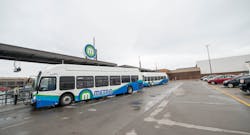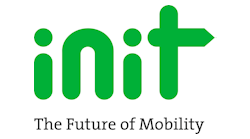MetroLINK By the Numbers
- 85% CNG Fleet
- More than 3.5M rides per years t
- 3 Channel Cat Water Taxis
The riverfront was lined with empty roads and factories in Moline, Illinois, after the meltdown of the economy. Home to the world headquarters of John Deere, the company dedicated to those linked to the land knew it needed to figure out a way to reinvest and ignite the community to help it transform away from the blue-collar factory and create an economy that was more diverse and more sustainable.
Rock Island County Metropolitan Mass Transit District (MetroLINK) General Manager Jeff Nelson said John Deere was heavily involved in creating an entertainment district. At the time, Moline didn’t really have a civic center. John Deere donated the land of one of its old factories, cleared the land and made a considerable multi-million dollar investment in a civic center.
It was a civic center without any restaurants or bars, so HOK was hired to come in and do a downtown land snapshot to visualize, what would a robust downtown look like? While the current director at the civic center wanted to knock everything down for acres of parking around the center, HOK came back and said no, you can’t do that.
“HOK was big on looking into the future of what public transportation’s role was going to be,” said Nelson. “We were invited to the table to build our new downtown transit center right in the middle of this.
“A community our size usually throws transit out down the street and around the corner,” Nelson said. But here, MetroLINK built its Centre Station, an intermodal transit hub, right in the middle of the $190 million development.
Community Relationships
Nelson knows the community well, as he’s one of the few people that stayed in the community he grew up in. He got out of college and started in commercial insurance, writing insurance for small and medium-sized businesses. Then in the early 80s during the farm implement meltdown, the major employers closing down had a trickle-down effect.
“When you work in a commission-based world and you’re writing more cancellations than new policies, the economics of it suggest you need to broaden your horizons a little,” he joked.
One of the clients was the transit authority, which had recently built a new maintenance facility. Nelson said, “The guy called me back about two months later and asked, ‘Are you interested in a job outside of insurance?’
“I said sure, I would take a look.” He added, “I thought I would do that for a couple of years.”
Nelson started in September 1983, moved up to assistant general manager a year or so later. When he was contemplating a job change, leaving the industry, his boss called him in and said he was leaving and was going recommend Nelson for the GM position. “Timing is everything,” Nelson said.
Back at that time, transit was focused on providing service to those that had no choices, said Nelson. However, he said MetroLINK was shifting to transforming into something completely different, back when the federal government started investing in transit and the locals started investing in transit.
“What we did as an agency,” he explained, “we don’t have yellow school buses in two of our major cities so we expanded the concept of transit trippers. By that you’re now grabbing a generation that wasn’t familiar with transit and bringing them into the transit world.
“They started having a much higher comfort level and you can almost see that evolution … acceptance of transit was much different.”
Building acceptance in the community is something that doesn’t come easy and to further that, Nelson said they had to get involved. “Chambers of commerce are sometimes under-valued in people’s minds,” he said. “I got deeply involved in our chamber of commerce. Volunteerism is critical so if you’re not volunteering in different community groups, people see you, hear you differently.
“Become a part of that community and slowly but surely, you get invited to conversations that you get to play a bigger role in.” He continued, “When you’re around long enough, you start to understand who in the community are actually making things happen and it may not necessarily be that elected official.”
He emphasized, “You can’t sit behind your desk and think someone’s going to knock on your door; it’s not going to happen.
“I make my staff get involved, too. The more people you can have integrated into a community, the better off you are.”
He explained that sometimes it’s even organizations that don’t have anything to do with transit; you start collecting a new group of people that have different perceptions.
Nelson said, “We have two distinct groups out there, the users and non-users. The non-users have to be as knowledgeable of the system as the users.”
Partners in Technology
A shift in perception from non-users was really apparent when they got their first compressed natural gas (CNG) buses.
Walking a trade show floor, Nelson saw John Deere exhibiting and stopped by to see what they were doing exhibiting at a transit conference. Back in the late 90s, early 2000s, John Deere was having to look for the diesel output exchange for off-road vehicles, they were getting credits for building environmental engines to get credit for building ones that maybe weren’t so environmentally friendly. They were trying to find a market for natural gas engines.
“I asked, ‘What are you guys doing, what are you selling,’” said Nelson. “It wasn’t two weeks later their whole sales staff was in my front office standing, saying, ‘How are we going to buy some buses?’”
MetroLINK laid out its plan, was fortunate to get federal and state funding and then got its first CNG buses in 2002. J
Prior to this, Nelson said the natural gas buses they were seeing was converted diesels and the fuel performance was really low. The purpose-built CNG engine, the elaborate electronic fuel system, it all brought the fuel economy up to almost diesel’s levels.
Working with El Dorado National, they did the preliminary research and development to get the John Deere engines in the first round of buses. After that, John Deere put together – with a sizeable contribution – a full marketing rollout, funding a series of TV commercials, print media and the rest to tout the benefit of natural gas engines in the community.
“That was one of the fundamental biggest changes that we’ve had in a non-user perspective for us, when we went to natural gas,” Nelson stressed. “People were calling us, ‘I just followed your bus and it was great, there was no emissions.’
“When you partner with somebody that has a name like ‘John Deere’ … that was pretty significant.”
Though they got on board with CNG early on, it was a pretty smooth transition. John Deere brought in a group of junior college professors and put on a “John Deere College.” Before MetroLINK was deeply involved, they took all of the mechanics off the floor and they did a three-day program on understanding natural gas.
Following that, Nelson said they had their maintenance team talking highly of how great this natural gas will be and that spilled over to the operators having a comfort level.
“When you look at who’s going to scuttle a project the quickest in the technology scene, it’s probably going to be maintenance,” he said.
While the community itself wasn’t too concerned, the fire departments were another story. “We’re bringing something new into the community … any changes are important to them,” explained Nelson.
“It was a learning curve for us to train those front line firemen to understand natural gas is no different than another vehicle going down the street.”
Currently, MetroLINK’s fleet is 85 percent CNG. Next for MetroLINK is all-electric. Proterra brought in one of its buses and tested it out in the community. MetroLINK got a grant through the state of Illinois, some of the clean energy money. Two all-electric buses will be coming in August.
The Metro Operations & Maintenance Center has a photovoltaic roof, so Nelson said they’re trying to build a cycle for those buses to charge them with sunlight. While January and February will be plugging into the wall more than anything, they anticipate charging during the day for at least three-quarters of the year with the 325 kW system they have.
Technology Choices
At MetroLINK they know if it’s not in the rider’s palm, it’s not an option. They’re working with TransLoc on rolling out an app that will have the bus “in the palms of people’s hands.” They’ve already started rolling out real-time information signs on shelters. They’re testing a cellular connection with AT&T so those signs will be working off the AT&T connection and have Wi-Fi capability, as well.
“Technology’s really going to be, I think, the element that’s going to change and make transit viable in a community,” Nelson stated.
When talking about technology and apps, Nelson mentioned they were considering their fareboxes about six years ago. “It you start thinking about what’s evolved in six years, it’s been pretty dramatic,” he said. “If we had replaced our fareboxes six years ago, we would be so antiquated.
“We know we we’ll always have to have that stainless steel box to catch cash, but what is going to be that mean of paying your way in life? … at what point do you say yes, we’ve found a comfort level … something that will be sustainable for years.”
With such a significant investment, he said they want to ensure they’re not going to be antiquated before they “plug it in.”
They have been dipping their feet in the mobile payment arena with their ferry boats. The ferry boats have about 50 percent ridership that is one-time riders and electronic transactions really aren’t an option. Where the docks are, there aren’t any registers and they looked at a cellular connection to do credit card transactions, but that also wasn’t an option.
Nelson said they worked with Americaneagle.com out of Chicago to develop a mobile payment app, the Channel Cat app. Riders can download the app, populate it with their credit card information and buy the ticket on the spot. It provides a QR code and MetroLINK has readers on the boats.
Planning with Purpose
Maintenance and Operations Center by the Numbers
- 150,000 sq ft facility
- 32 Solar Thermal Panels
- 1,344 PV Solar Panels
- 1st Indoor diesel & CNG transit fueling stations in IL
The building they were in up until 2014 was built too small from the beginning. As Nelson explained, it was undersized before they even moved in. They had built it around the time ADA changes came and the buses went from 96 to 102 inches wide and while that doesn’t sound like much, with beams that can’t be moved, walkways became too narrow, the bus wash became too small, turning radiuses changed; the dynamics of the building were no longer functional.
The preliminary study looked at what it would take to make the building work and it came with, not much.
For the strategic plan, they focus on in a perfect world, what would they want and how would they get there? “You have to have the ability to look forward,” Nelson said. “And you can’t wait until funding happens.”
The Metro Operations & Maintenance Center was a 15-year endeavor from start to finish. They looked at if they were going to build a new facility, what would the ideal facility look like? And they designed from there, understanding the square foot needs and funding needs. “We did the preliminary search … we got a lot of the procedural stuff out of the way,” explained Nelson. “A lot of people were asking, ‘Why are you doing an environmental for your new building if you don’t have any funding for it?’
“In today’s world, you never know when that bucket of money is going to show up,” he said. “You can start knocking down some of those things that sometimes eliminate projects from consideration.
“We had everything knocked out and ready to go and then lo and behold, the state of Illinois has a capital bill. Well we just happen to have something that’s shovel ready.
“Is it guessing? No, not really.” He added, “If you’ve been in it long enough you know there’s a cycle of major investment. Every so often states and feds will make their major investments.”
Significant investments don’t happen overnight, so the long planning process allowed them to start assembling a variety of different funds. For this project he said they had probably 8 “buckets of money,” including federal, state and local dollars, and they also had a significant grant for the photovoltaic roof and incentives to be more efficient.
Key to funding is the relationships with legislators. Nelson said, “You don’t get part of a capital bill without a legislator that thinks it’s important for his district.” He added, “The politics of it all are always very key.
“As much as everyone thinks there’s a pure world of funding out there, it’s as purse as how well your congressional folks push for stuff. You’ve got to get them involved, you’ve got to get them to understand the value of seeking funding for you on your behalf.
“A lot of times … it’s not to say I’ve got to have something. A lot of times it’s just talking about what we’re doing and some of the strategic elements we’re working on.”
When it comes to lessons learned from the project, he joked, “Never trust a contractor.” He explained, “They’re there to make money. It’s not that they’re there to steal; if they can do it in a more cost-effective way, their profit margin goes up.”
In 2005, Nelson asked the transit and maintenance manager for the city of Bettendorf, which is across the river, to look over the plans for the building. As someone not invested in the system, another set of eyes looking at it from a maintenance perspective. Later, he was brought on as a consultant. Today, Matt Simaytis is the director of maintenance at MetroLINK.
In April of 2014 the building was complete and they moved everything from one building to the other. Simaytis said, “We didn’t have the opportunity to miss any service because we run every day.”
Nelson said service left in one garage and came back that night to a different one.
When talking about differences between the buildings, one of the first things Simaytis spoke of was the efficiency for fueling. In the previous garage it was a 45-minute process to fuel a bus and get it parked, as the fueling site was off site. And whether or not there would be room to park inside was also an issue.
Today, if everything’s going smoothly, it’s a 12-minute process and it now includes cleaning and washing the bus.
The CNG fueling station is indoors at this facility and all of the vehicles, including the ferry boats, are parked indoors.
A unique aspect of the facility is that everybody goes through the same door. Administrators, maintenance folks, bus operators, everyone enters through the same entrance. Nelson explained, “By bringing everybody to the same level, it’s easier to have conversations … a lot of conversations can occur that don’t normally happen.”
Customer service is at a separate facility so employees can come to work, feeling comfortable as they wanted to make it a place people would want to come to work. He said, “You need some appeal.”
Future Plans
Moline Multi-Modal Station Funding By the Numbers
- TIGER II Grant $10M
- State of IL Capital Assistance Grant $4,943,250
- Local Funding $1,691,000
- Total Public Funding $16,634,250
Under construction is the Moline Multi-Modal Station, The “Q.” The state of Illinois was successful in getting money to build out a high-speed rail (HSR) corridor from Chicago to Moline. In 2010, a $230 million High-Speed Intercity Passenger Rail (HSIPR) grant was awarded to the state of Illinois and Iowa Departments of Transportation to establish passenger rail service between Chicago and the Quad Cities. The state of Illinois received a TIGER grant to build a train station and instead of building a stand-alone building, they decided to do a joint development in an old warehouse.
A six-story warehouse was converted into a mix of public and private development. Station amenities include waiting areas, real-time information signage, restrooms, station platforms and rail passenger parking.
MetroLINK is working with the city of Moline as the designated receipient, able to work through the federal and state dollars grant process more efficiently than they are, but MetroLINK doesn’t own anything. “You don’t want be asset heavy,” said Nelson. “We’re managing the project on their behalf.”
Construction is under way and is expected to be complete in July, 2017.
There’s always another project on the horizon at MetroLINK, which is what’s kept Nelson there, he joked. With so much going on, he said there’s always that one project he wants to finish. He said, “I’m one of those that starts something and then can’t mentally hand it off and say, ‘Good luck’ to somebody else …
“I just haven’t gotten finished.”






